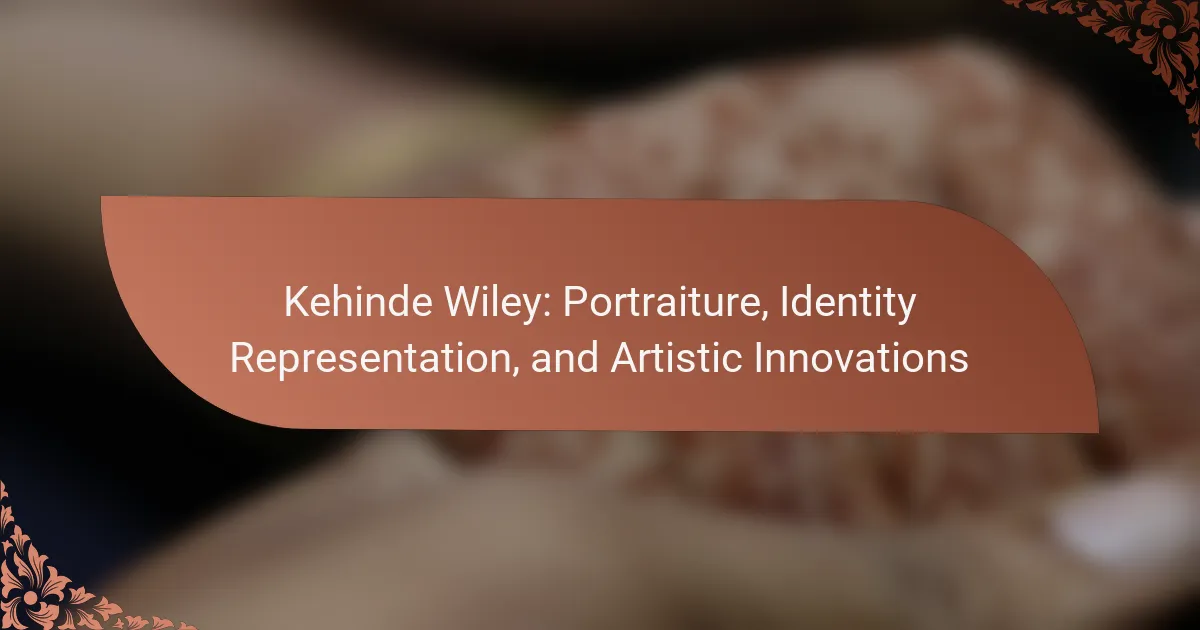Kehinde Wiley’s work challenges traditional representations of identity and race through innovative portraiture. He combines historical European styles with contemporary subjects, elevating marginalized figures. His vibrant, large-scale portraits foster dialogue about cultural heritage and visibility. Diverse audiences perceive his art through different cultural lenses, highlighting themes of power and representation.
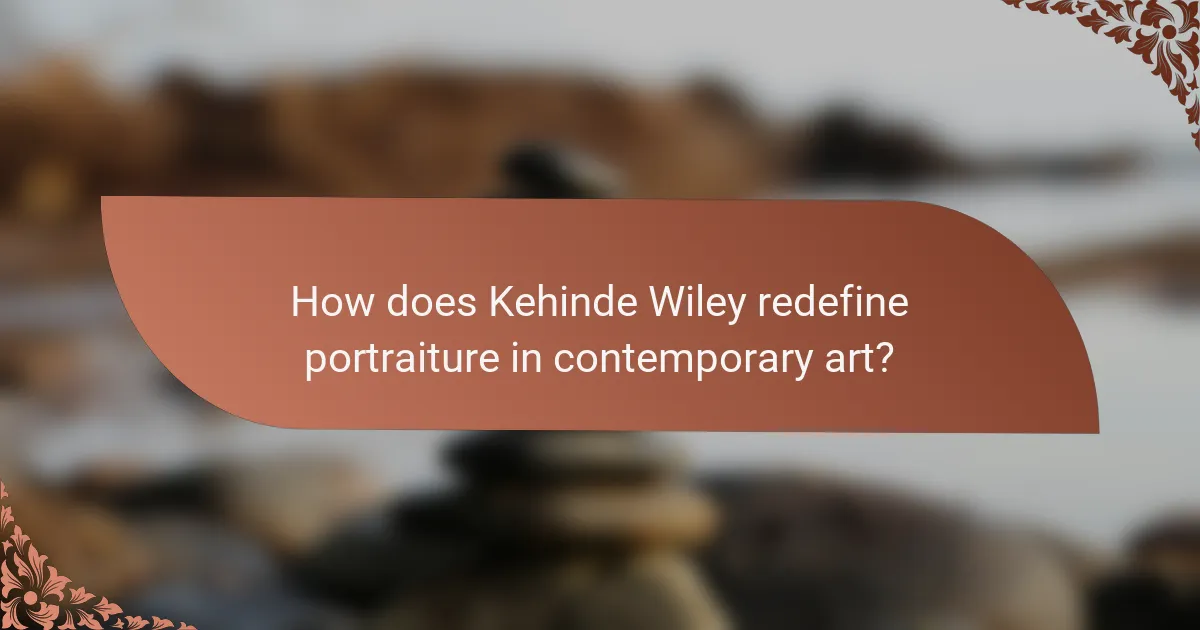
How does Kehinde Wiley redefine portraiture in contemporary art?
Kehinde Wiley redefines portraiture by incorporating contemporary identity representation and innovative artistic techniques. His work challenges traditional notions of race and power through vibrant, large-scale portraits of people of colour. Wiley’s unique attribute lies in his use of historical European portraiture styles, which he adapts to celebrate and elevate marginalized identities. This approach fosters a dialogue about cultural heritage and visibility in art, making his pieces both visually striking and socially relevant. As a result, Wiley’s art not only reinterprets the genre but also expands its meaning in today’s context.
What techniques does Wiley employ to challenge traditional representations?
Kehinde Wiley employs techniques that subvert traditional representations by recontextualising historical portraiture. He integrates contemporary subjects, often people of colour, into classical poses and settings, challenging societal norms. Wiley’s use of vibrant patterns and symbolism further enhances identity representation, making the viewer reconsider preconceived notions of power and beauty. His artistic innovations, such as large-scale canvases and intricate backgrounds, create a dialogue between past and present, emphasising the importance of diverse narratives in art.
How do colour and pattern play a role in Wiley’s work?
Colour and pattern are essential in Kehinde Wiley’s work, enhancing identity representation and challenging traditional portraiture. Wiley uses vibrant colours and intricate patterns to create visually striking backgrounds that reflect cultural heritage. This approach not only emphasises the subjects’ identities but also connects them to their historical and social contexts. The unique attribute of Wiley’s style lies in his ability to blend contemporary figures with classic art influences, creating a dialogue between past and present. As a result, his portraits provoke conversations about race, identity, and representation in art.
What themes are prevalent in Wiley’s portraiture?
Kehinde Wiley’s portraiture often explores themes of identity, race, and power dynamics. His works challenge traditional representations by featuring people of colour in heroic poses, subverting historical art norms. Wiley’s use of vibrant patterns and intricate backgrounds enhances the narrative of cultural identity. Additionally, he incorporates contemporary urban elements, bridging the gap between past and present.
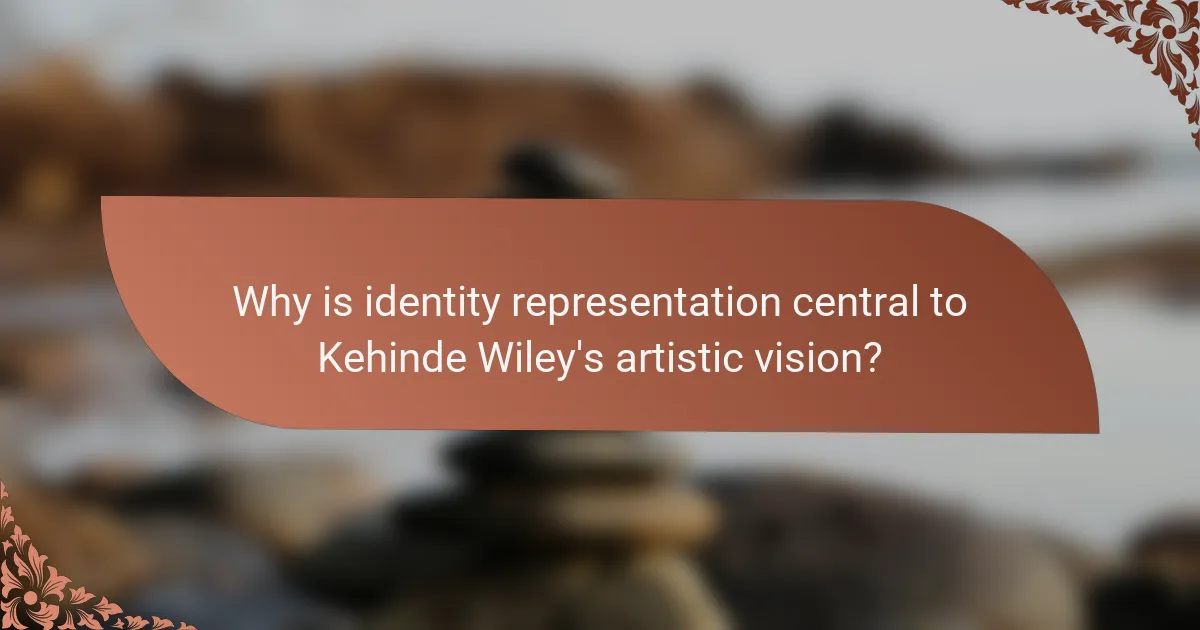
Why is identity representation central to Kehinde Wiley’s artistic vision?
Identity representation is central to Kehinde Wiley’s artistic vision because it challenges traditional norms and highlights the complexity of identity. Wiley’s portraits elevate marginalized figures, showcasing their power and presence in a historical context. His unique approach combines classical portraiture with contemporary subjects, creating a dialogue about race, identity, and societal roles. By using vibrant patterns and backgrounds, he redefines representation, making it both personal and universal. This artistic innovation invites viewers to reconsider their perceptions of identity and the narratives surrounding it.
How does Wiley’s background influence his exploration of identity?
Kehinde Wiley’s background significantly shapes his exploration of identity through personal experience and cultural heritage. Growing up in a multicultural environment, Wiley’s work reflects themes of race, power, and representation. His artistic innovations challenge traditional portraiture by placing marginalized subjects in positions of power, transforming the narrative around identity. Additionally, his unique approach incorporates historical references, which deepens the conversation about self-identity in contemporary society.
In what ways does Wiley address issues of race and culture in his art?
Kehinde Wiley addresses issues of race and culture through his vibrant portraiture that reimagines classical themes. His work often features people of colour, challenging historical narratives and representation in art. Wiley’s unique approach includes integrating cultural symbols and contemporary fashion, which highlights identity and social commentary. By placing marginalized figures in grandiose settings, he transforms perceptions of power and beauty in art.
Which historical figures does Wiley draw inspiration from, and why?
Kehinde Wiley draws inspiration from historical figures such as Jean-Auguste-Dominique Ingres and Kehinde Wiley himself. He reinterprets classical portraiture to challenge traditional representations of identity. Wiley’s work often reflects themes of race, power, and cultural heritage, merging historical references with contemporary narratives. This approach emphasises the significance of visibility and representation in art.
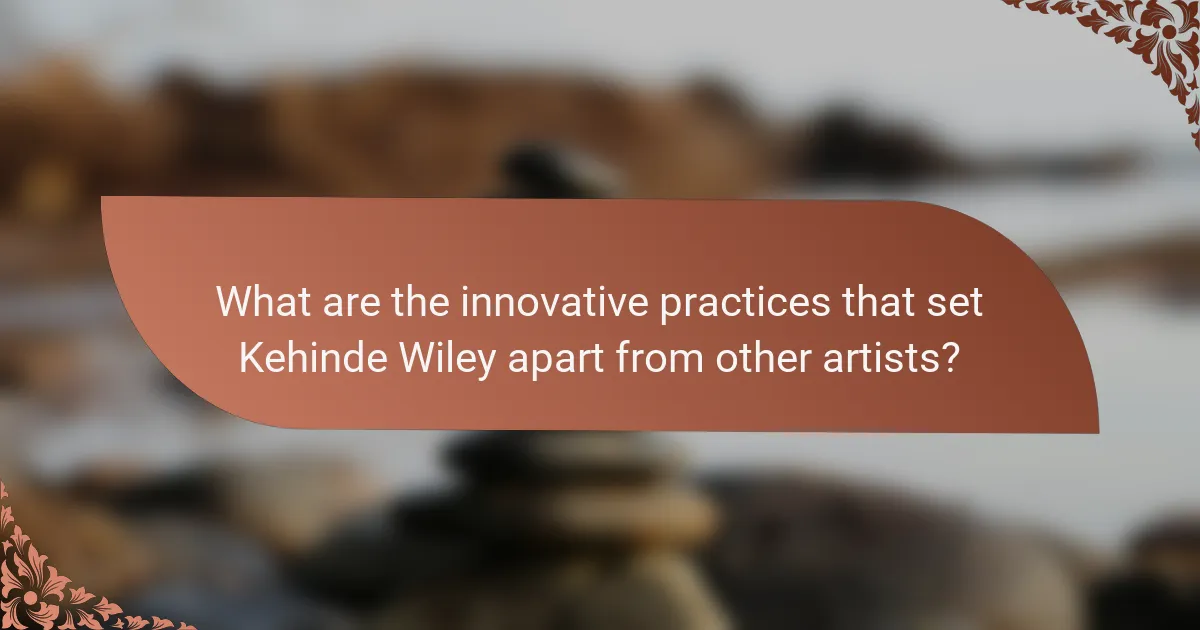
What are the innovative practices that set Kehinde Wiley apart from other artists?
Kehinde Wiley’s innovative practices include bold reimagining of classical portraiture, vibrant colour palettes, and the integration of cultural identity. His work uniquely challenges traditional representations by featuring people of colour in heroic poses against ornate backgrounds. This approach not only elevates marginalized voices but also invites dialogue about race and identity in contemporary art. Wiley’s commitment to inclusivity and narrative depth sets him apart in the art world.
How does Wiley incorporate technology into his art-making process?
Kehinde Wiley incorporates technology into his art-making process through digital tools and innovative techniques. He utilises digital photography to create compositions, allowing for precise detail and vibrant colours. Wiley often employs digital manipulation to merge traditional portraiture with contemporary themes. This integration enhances his exploration of identity and representation, making his artwork resonate with modern audiences. Additionally, Wiley’s use of technology facilitates collaboration with other artists and institutions, expanding the reach and impact of his work.
What role does collaboration play in Wiley’s artistic projects?
Collaboration is central to Kehinde Wiley’s artistic projects, enhancing diversity and innovation. His partnerships with various artists and communities deepen cultural narratives and expand representation in portraiture. Collaborative efforts allow for a fusion of styles and perspectives, resulting in unique compositions that challenge traditional norms. This approach not only enriches Wiley’s work but also fosters a dialogue around identity and inclusivity in contemporary art.
Which unique formats or mediums does Wiley utilize?
Wiley utilises diverse formats such as traditional oil painting, large-scale murals, and digital media. His work often incorporates elements of photography and mixed media, enhancing identity representation. Unique attributes include his signature style, which merges classical portraiture with contemporary themes. Rarely, he employs textiles and sculpture, showcasing artistic innovations.
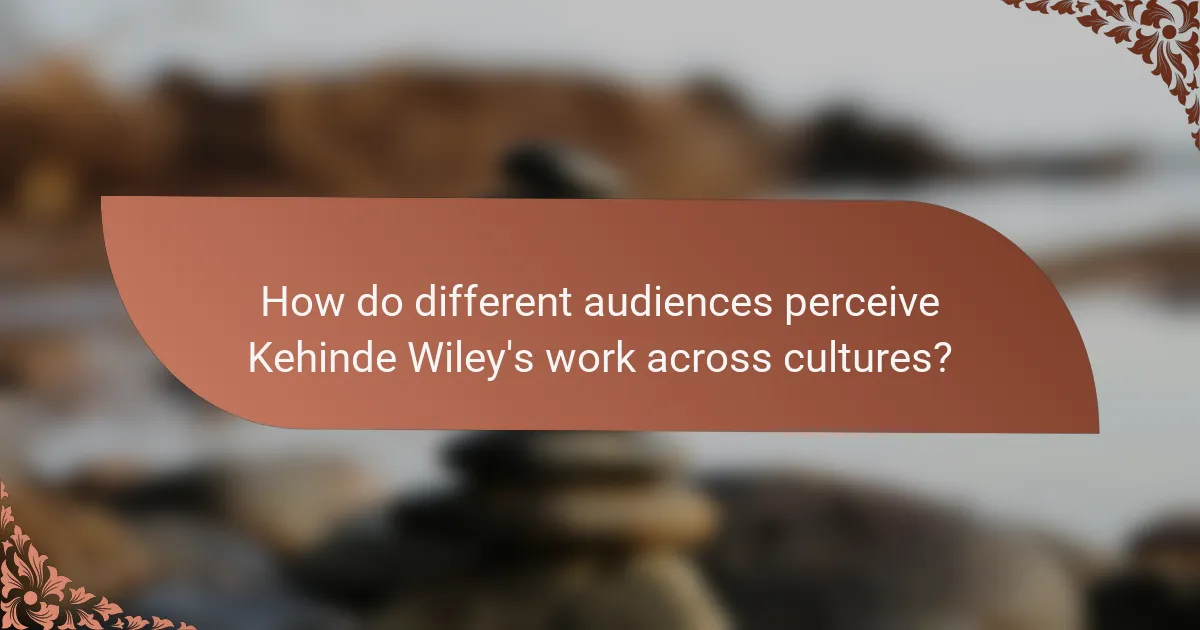
How do different audiences perceive Kehinde Wiley’s work across cultures?
Different audiences perceive Kehinde Wiley’s work through diverse cultural lenses, often highlighting themes of identity and representation. In Western contexts, his portraits challenge traditional notions of power and privilege by placing Black subjects in classical poses. Conversely, audiences in African cultures may interpret his work as a celebration of heritage and history, emphasising cultural pride. Asian viewers often appreciate the fusion of contemporary and traditional art forms, reflecting Wiley’s innovative approach. These varied perceptions demonstrate how cultural backgrounds shape the understanding of Wiley’s artistic innovations and his commentary on societal issues.
What challenges does Wiley face in reaching diverse audiences?
Wiley faces challenges in reaching diverse audiences due to cultural representation, accessibility issues, and varying artistic interpretations. The need for authentic representation can alienate some groups. Limited outreach strategies may hinder engagement with underrepresented communities. Additionally, the complexity of Wiley’s themes might not resonate universally, affecting audience connection.
How do cultural contexts shape the interpretation of Wiley’s portraits?
Cultural contexts significantly influence the interpretation of Kehinde Wiley’s portraits by shaping viewers’ perceptions of identity and representation. Wiley’s work often challenges traditional notions of portraiture, incorporating elements of African American culture and history. This context invites diverse interpretations based on individual cultural backgrounds and experiences.
For instance, Wiley’s use of vibrant colours and ornate patterns reflects African heritage, which may resonate differently with audiences familiar with these cultural elements. Additionally, the juxtaposition of contemporary subjects against classical backdrops prompts discussions about race, power, and visibility in art.
Furthermore, the unique attribute of Wiley’s portraits lies in their ability to reclaim and redefine identity through representation. By placing Black figures in positions of prominence, he subverts historical narratives that often marginalised these identities. This artistic innovation encourages viewers to reflect on their own cultural contexts and biases, enhancing the depth of interpretation.
In summary, Wiley’s portraits serve as a lens through which cultural contexts shape the understanding of identity, prompting a dialogue that varies across different audiences.
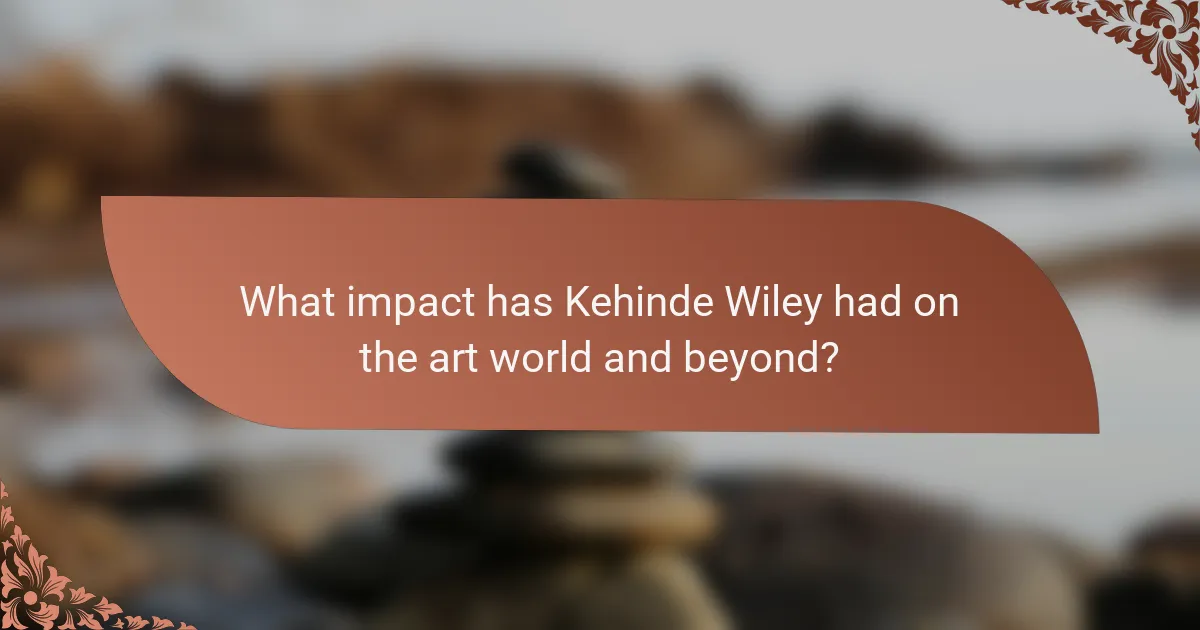
What impact has Kehinde Wiley had on the art world and beyond?
Kehinde Wiley has significantly influenced the art world through innovative portraiture that challenges traditional representations of identity. His work redefines cultural narratives by placing people of colour in classical poses, promoting inclusivity and diversity in art. Wiley’s unique approach has inspired a broader dialogue on representation, impacting contemporary art and social discourse. His portraits often feature vibrant patterns and intricate backgrounds, merging historical and modern elements, which further emphasises the richness of cultural identity. As a result, Wiley has become a pivotal figure in contemporary art, pushing boundaries and encouraging new perspectives on race and representation.
How has Wiley influenced discussions around representation in art?
Kehinde Wiley has significantly influenced discussions around representation in art by showcasing diverse identities in portraiture. His works challenge traditional narratives by featuring people of colour in classical poses, thus redefining the concept of heroism in art. Wiley’s innovative approach highlights the intersection of identity and power, prompting critical conversations about inclusivity in contemporary art. His commitment to elevating marginalized voices reshapes viewers’ perceptions and encourages broader representation across artistic platforms.
What legacy is Kehinde Wiley creating for future generations of artists?
Kehinde Wiley is creating a legacy of bold identity representation and artistic innovation for future generations. His work challenges traditional portraiture by featuring people of colour in grand historical contexts, redefining power dynamics in art. Wiley’s unique approach elevates underrepresented voices, inspiring artists to explore identity and cultural narratives. His commitment to social commentary through art encourages future creators to engage with societal issues, fostering a more inclusive artistic landscape.
What are the best practices for engaging with Kehinde Wiley’s art?
Engaging with Kehinde Wiley’s art involves appreciating his unique portrayal of identity and cultural narratives. Viewers should consider the historical context of his subjects, often depicted in vibrant settings that challenge traditional portraiture. Analyse the interplay of race, power, and representation in his work. Attend gallery exhibitions to experience the scale and detail of his pieces. Participate in discussions or workshops to deepen understanding of his artistic innovations and their societal implications.
